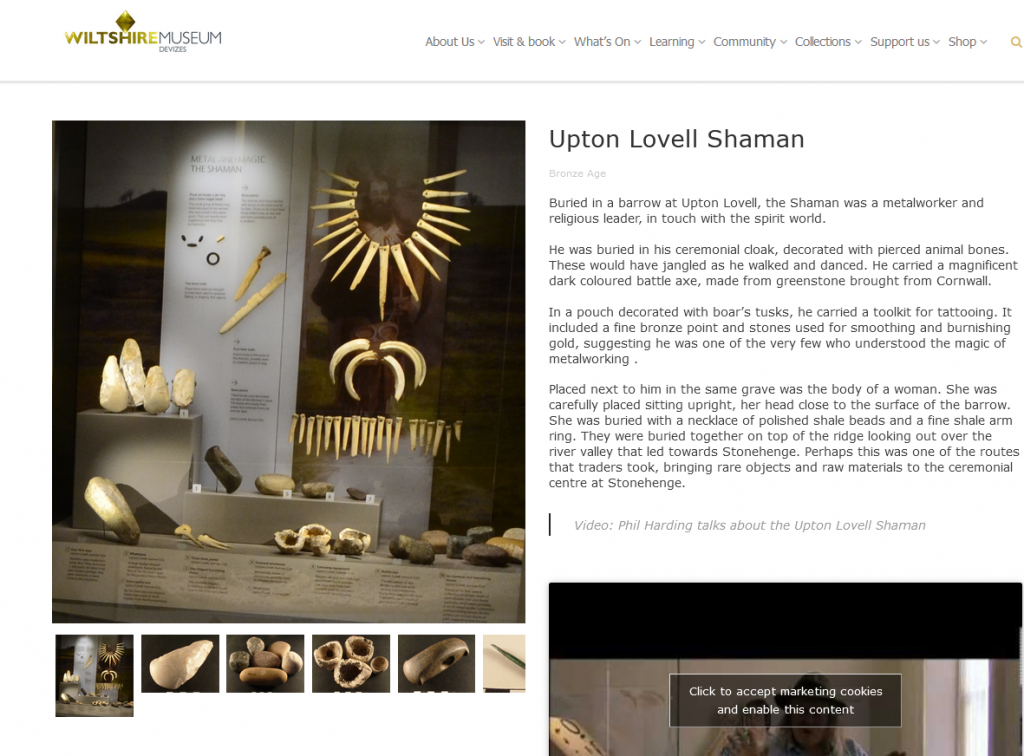‘Materials in movement: gold and stone in process in the Upton Lovell G2a burial’

The journal Antiquity reports amazing discoveries in a paper called : ‘Materials in movement: gold and stone in process in the Upton Lovell G2a burial‘ and citing that the paper is
‘advancing a new materialist approach, we identify a goldworking toolkit, linking gold, stone and copper objects within a chaîne opératoire,
Setting aside what ‘new materialism’ and ‘chaîne opératoire’ are for the moment. Briefly, their analysis of the objects found in the Bronze Age burial of two people evidence that the person(s) identified as a ‘shaman’ on the basis of clothing/jewellery was (as well?) a gold worker. What is amazing is that they were using Neolithic axes which would have been hundreds of years old to make gold sheets. There was also evidence interpreted as tattooing instruments. As Upton Lovell is 12 miles from Stonehenge it means this is big news in the archaeological world, making most of the newspapers.
The authors dig deeper into the meaning of ‘New materialism’:
‘This approach advances on traditional technological studies in two ways. First, whereas materials are usually approached as having fixed properties, new materialists argue that these properties emerge relationally; they change through time and in combination with other materials, people and places (cf. Barad Reference Barad2007; Bennett Reference Bennett2010). Second, ‘making’ is seen not as the simple imposition of the will of a maker on an inert material but, instead, materials play an active role in the process.’
Widipedia gives a definition of chaîne opératoire
To put it more simply objects have complicated histories and contexts. You might also like to look at the original article (link below) which is written in a very strange style which gives the objects agency ‘an active role in the process’. Below is the conclusions of the article.
‘Conclusions
Drawing on microwear, residue analysis and new materialist theory, we have reassessed the Upton Lovell G2a grave assemblage. The empirical techniques attend to the materials, which are reinvigorated by situating them within this emergent theoretical landscape. These approaches reveal how the grave goods disclose an intertwining set of processes. Never static, these objects changed and shifted, requiring modification, repair and reuse. They speak to a complex interweaving of bodies—human and non-human—and their varied histories. There is far more complexity here, in relations, histories, gestures and processes, than could ever be captured under the label ‘shaman’, ‘metalworker’ or ‘goldsmith’. Grave goods are more than representations of a person’s identity. They are more even than critical relations in the construction of identity (cf. Brück Reference Brück2019). What these grave goods stress, when attention is paid to their stories, is quite different. They speak of material journeys, the colour of stone and the texture of gold capturing relations that flow across landscapes. Collectively, as an assemblage, these stone tools reveal a process of goldworking. But this goldworking involves as much the working of stone, in the shaping and upkeep of tools, as it does of metal. Here, we emphasise the repetitive and iterative nature of our chaîne opératoire, each action calling into being further moments of renewal of the polished stone surfaces so essential to the qualities other materials elicited. This goldworking chaîne opératoire is multi-material; it is as much a process in stone working as it is in the working of metal. From this perspective, the similarities in processing and working gold and stone mean that the former emerges as far more like the latter than our modern taxonomies would suggest.’
Materials in movement: gold and stone in process in the Upton Lovell G2a burial
If we analyse this conclusion based on the literary idea of ‘Point of View‘ you will see that the POV of the piece above is just bonkers. There is the ‘we’ of the authors, and the ‘they’ of the objects. ‘They’ are speaking to ‘bodies – human and non-human’. ‘They’ even have the ability to ‘stress’ an issue once ‘attention is paid to their stories’ and to be ‘reinvigorated’.
But its a very interesting find and analysis and does remind us that things are much more complicated than we realise.
I have republished my post of the Chinese New Year which you can see here:
I have republished my post of the Chinese New Year which you can see here:
I have republished my post of the Chinese New Year which you can see here:
Discover more from And Did Those Feet
Subscribe to get the latest posts sent to your email.
